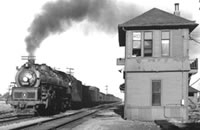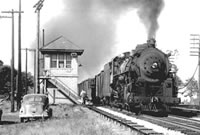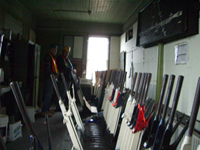|
Increasing traffic levels along America's railroads in the late nineteenth century warranted the use interlocking towers as a way to safely control the movement of trains. Interlocking towers were normally found near intersecting rail lines and junctions, although towers could be found anywhere the railroad deemed necessary.
 The railroad tower (or cabin as some railroads called them) housed an interlocking machine that was controlled by an operator or leverman. The operator would pull various levers, which would in turn would align switches and signals through a series of trackside pipes. These levers were often referred to as "armstrong" levers because you had to have a strong arm in order to operate the machine as the pipes could be up to a mile in length! The railroad tower (or cabin as some railroads called them) housed an interlocking machine that was controlled by an operator or leverman. The operator would pull various levers, which would in turn would align switches and signals through a series of trackside pipes. These levers were often referred to as "armstrong" levers because you had to have a strong arm in order to operate the machine as the pipes could be up to a mile in length!
The interlocking machine itself was actually an early type of computer. The ingenious design of the interlocking mechanism allowed the operator to manipulate various levers without permitting conflicting routes and thus preventing accidents. Each interlocking machine was custom designed and built for the specific section of track it was meant to control.
 An interesting feature of railroad towers was how they were constructed. The interlocking machine would be installed at the site first, then the frame of the tower would be built around the machine. Interlocking towers were built as two-story structures because of the size and complexity of the interlocking machine. The inner workings of the machine were located on the first floor while the operator was on the second floor. An interesting feature of railroad towers was how they were constructed. The interlocking machine would be installed at the site first, then the frame of the tower would be built around the machine. Interlocking towers were built as two-story structures because of the size and complexity of the interlocking machine. The inner workings of the machine were located on the first floor while the operator was on the second floor.
Although mechanical interlocking towers were a technological achievement for the railroads in the late 19th century, newer ones were built with electrical or electro-pnuematic components with switches and signals controlled with a simple twist of a handle. Railroad technology continued to evolve, and thousands of towers across the United States eventually fell victim to more modern advancements in train control. As early as the 1930's, railroads began closing interlocking towers in favor of centralized traffic control (CTC) as a way to manage the movement of trains. After World War II, the railroads continued pushing CTC as the practical way of controlling train movements. More and more towers continued to close and by the 1980's most railroad towers in the United States had been replaced by computer control in remote dispatching centers.
 Railroads have been very aggressive in eliminating manually controlled interlocking towers over the last half century. However, a few towers still remain in operation a hundred years or more after they were constructed - a true testament to their engineering. Railroads have been very aggressive in eliminating manually controlled interlocking towers over the last half century. However, a few towers still remain in operation a hundred years or more after they were constructed - a true testament to their engineering.
|